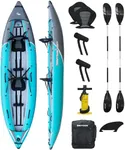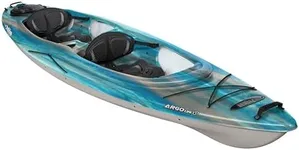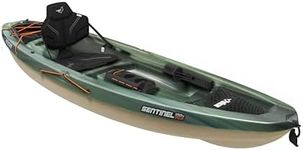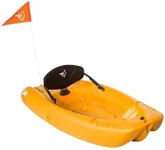Buying Guide for the Best Kayaks For Beginners
Choosing your first kayak can be exciting but also a bit overwhelming with all the options out there. The key is to focus on what kind of paddling you want to do, where you'll use the kayak, and how comfortable you feel on the water. As a beginner, you'll want something stable, easy to handle, and not too heavy. Understanding the main features will help you pick a kayak that matches your needs and helps you enjoy your time on the water safely and comfortably.Type (Sit-on-top vs. Sit-in)The type of kayak refers to whether you sit on top of the kayak or inside it. Sit-on-top kayaks are open and easy to get in and out of, making them great for beginners, warm weather, and casual paddling. Sit-in kayaks have an enclosed cockpit, which can offer more protection from the elements and better control, but they can feel less accessible for new paddlers. If you want something easy and safe for calm waters, a sit-on-top is usually the best choice. If you plan to paddle in cooler weather or want to learn more advanced skills, a sit-in might be worth considering.
LengthThe length of a kayak affects how it moves through the water. Shorter kayaks (around 8-10 feet) are easier to turn and handle, making them ideal for beginners and for use on small lakes or slow rivers. Medium-length kayaks (10-12 feet) offer a balance between maneuverability and speed, suitable for a variety of conditions. Longer kayaks (over 12 feet) are faster and track straighter, but can be harder to control for new paddlers. For most beginners, a kayak in the 9-12 foot range is a good starting point.
WidthWidth, or beam, is the measurement across the kayak at its widest point. Wider kayaks (over 30 inches) are more stable and less likely to tip, which is reassuring for beginners. Narrower kayaks are faster but can feel less stable. If you're new to kayaking or nervous about balance, look for a wider kayak to help you feel secure on the water.
Weight CapacityWeight capacity tells you how much weight the kayak can safely carry, including your body, gear, and any extras. It's important to choose a kayak with a weight limit that comfortably exceeds your total weight plus anything you plan to bring. If you overload a kayak, it will sit lower in the water and be harder to paddle. Always check this spec to make sure the kayak will perform well for you.
MaterialKayaks are made from different materials, which affect their weight, durability, and ease of transport. Most beginner kayaks are made from plastic (polyethylene), which is tough and affordable but can be heavy. Lighter materials like composite or inflatable options are easier to carry but may cost more or require more care. If you plan to transport your kayak often or carry it by yourself, consider the weight and durability of the material.
StabilityStability refers to how steady the kayak feels on the water. Beginners usually want a kayak with high primary stability, which means it feels steady when you first get in and paddle on calm water. This is often related to the width and hull shape. If you’re new to kayaking or plan to paddle on flat water, prioritize stability to build your confidence.
Storage and PortabilityThink about how you’ll store and transport your kayak. Some kayaks are lightweight or inflatable, making them easy to carry and store in small spaces. Others are heavier and require a roof rack or trailer. If you have limited storage space or need to carry the kayak by yourself, look for options that are easy to move and store.

















